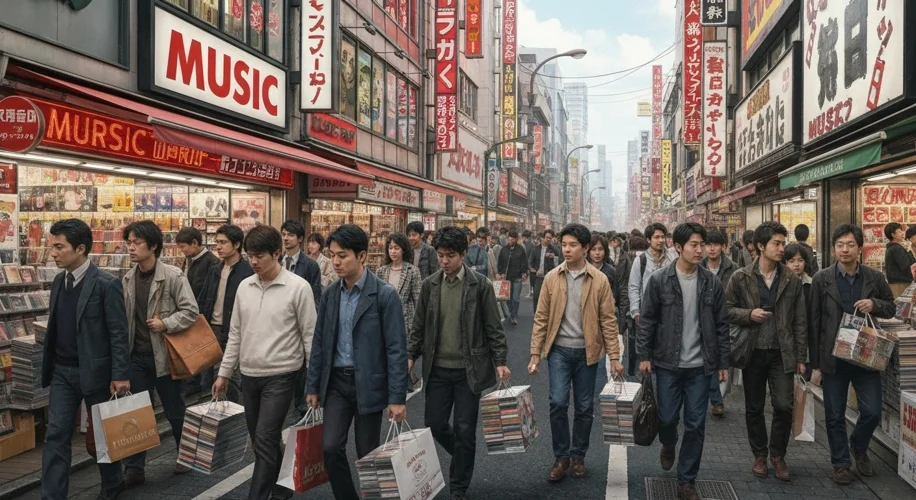For decades, the world marveled at the sheer, almost stubborn, resilience of Japan’s music market. Long before the digital age swept across the globe, turning physical media into relics, Japan stood as an island fortress, its CD and cassette tape sales soaring to heights unimaginable in other developed nations. This wasn’t mere happenstance; it was a carefully constructed ecosystem, nurtured by cultural quirks, savvy industry practices, and an unwavering consumer loyalty that seemed impervious to the tides of technological change.
The story of Japan’s pre-digital music dominance is one of deep cultural roots intertwined with economic shrewdness. In the post-war era, as Japan rebuilt and its economy surged, music became an integral part of its cultural renaissance. Unlike many Western markets that saw a fragmentation of music consumption, Japan cultivated a unique appreciation for the tangible. The CD, introduced in the early 1980s, was embraced with an almost religious fervor. Its pristine sound quality and the accompanying liner notes offered a sensory experience that resonated deeply with a society that valued craftsmanship and detail.

Several key factors contributed to this phenomenon. Firstly, the Japanese music industry, dominated by major labels and a tightly controlled distribution network, fostered an environment where new releases were meticulously managed and heavily promoted. The “Oricon” charts, a weekly compilation of music sales, became a powerful barometer of success, driving intense competition among artists and fervent support from fans eager to see their idols top the rankings. A single sold-out concert or a hit single could translate into millions of CD units sold, creating a virtuous cycle of demand and supply.
Secondly, the cultural emphasis on collecting and fan devotion played a pivotal role. Japanese music fans, particularly those of idol groups and J-pop stars, displayed an unparalleled level of dedication. Buying multiple copies of the same album or single was not uncommon, driven by the desire to support their favorite artists, collect different versions with bonus content, or even as a way to gain entry into fan events like handshake meetings or exclusive concerts. This fervent fan culture created a massive, built-in market that sustained physical sales even as digital alternatives began to emerge globally.
Consider the enduring popularity of artists like Namie Amuro, a reigning J-pop queen whose releases consistently topped the charts well into the late 1990s. Her albums, often accompanied by elaborate music videos and lavish packaging, were not just audio purchases but cultural artifacts. Fans would meticulously collect every edition, displaying them proudly. This collector’s mentality extended to the visual aspect of music as well. Music videos, often released on VHS and later DVD, were highly prized, further cementing the physical media’s appeal.
Economic factors also cannot be overlooked. While Japan enjoyed a period of robust economic growth, the cost of CDs, though higher than in some Western markets, was generally affordable for consumers who prioritized their entertainment spending on music. The perceived value in the physical product – the artwork, the lyric booklet, and the guaranteed sound quality – justified the investment. This was further bolstered by a robust retail infrastructure. Music stores were ubiquitous, from large department store chains to independent record shops, creating accessible points of purchase and fostering a sense of community around music discovery.
Furthermore, the industry’s cautious approach to digital distribution in the early days of the internet can be seen as both a strength and a potential weakness in hindsight. While digital music was gaining traction elsewhere, the Japanese market remained largely anchored to its physical format. This strategy protected the established revenue streams of the major labels but also meant that when the digital tide eventually broke, the transition was perhaps more abrupt than it might have been.
The consequences of this enduring strength were manifold. Japan became a vital engine for the global music industry, a significant market that major international artists and labels sought to conquer. The unique characteristics of the Japanese music scene, from its distinctive pop idols to its genre-bending rock bands, garnered international attention, influencing musical trends worldwide. However, by the turn of the millennium, the cracks in the fortress began to show. The global rise of MP3s and peer-to-peer file sharing platforms would soon present challenges that even Japan’s unique market could not indefinitely withstand.
In essence, Japan’s pre-digital music market was a testament to the power of cultural values, strategic industry management, and devoted fandom. It demonstrated that in a world increasingly drawn to the ephemeral, the tangible could still hold immense sway, leaving behind a legacy of robust physical sales and a unique chapter in the history of music consumption.

